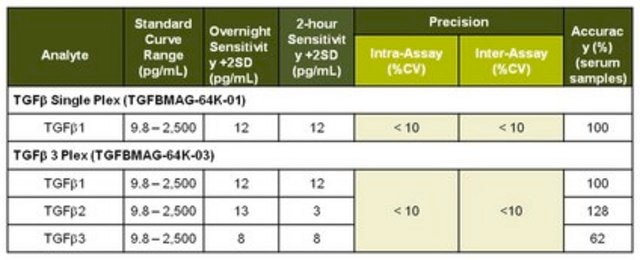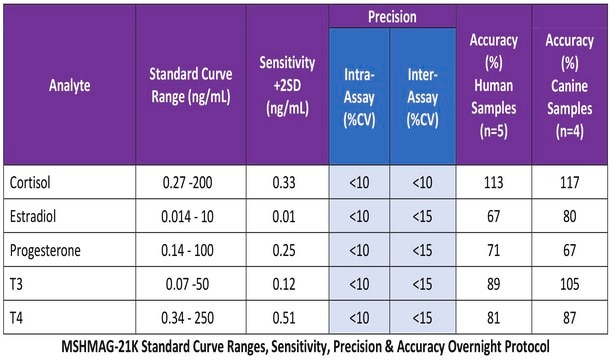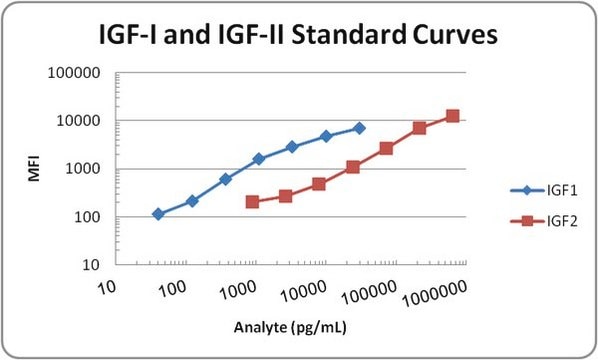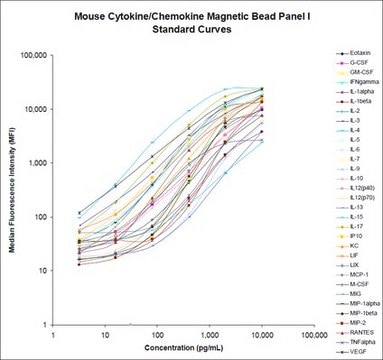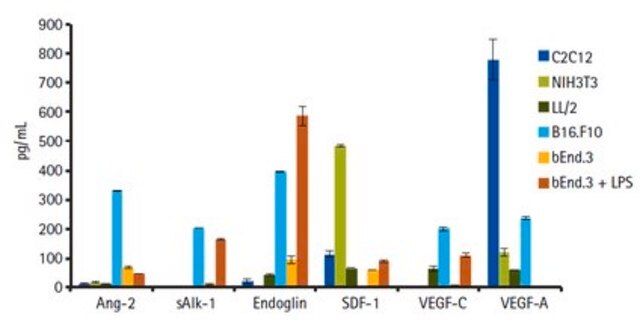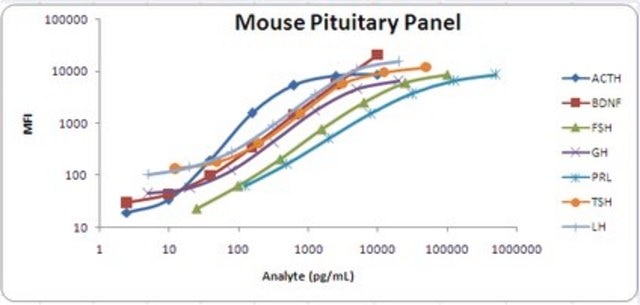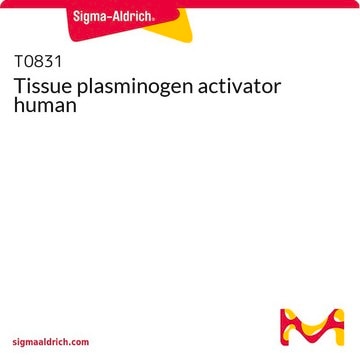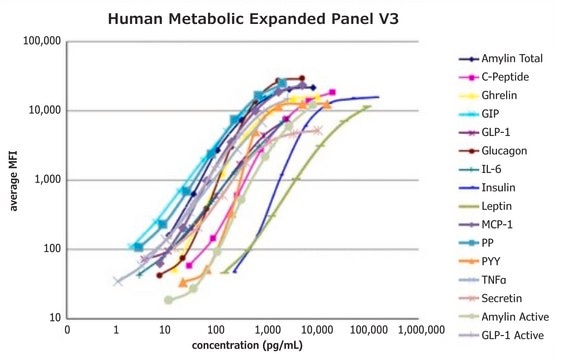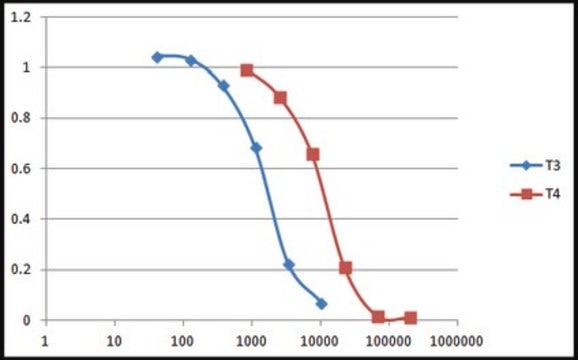HIGFBMAG-53K
MILLIPLEX® Human IGF Binding Protein Magnetic Bead Panel - Metabolism Multiplex Assay
The Human IGF Binding Protein Panel, using the Luminex xMAP technology, enables the simultaneous analysis of 7 IGFBP protein biomarkers in human serum, plasma and cell culture samples.
About This Item
Recommended Products
Quality Level
species reactivity
human
manufacturer/tradename
Milliplex®
assay range
accuracy: 79%
(IGFBP-5)
sensitivity: 0.01 ng/mL
(MinDC+2SD; IGFBP-1)
sensitivity: 0.07 ng/mL
(MinDC+2SD; IGFBP-7)
sensitivity: 0.12 ng/mL
(MinDC+2SD; IGFBP-6)
sensitivity: 0.15 ng/mL
(MinDC+2SD; IGFBP-3)
sensitivity: 0.96 ng/mL
(MinDC+2SD; IGFBP-4)
sensitivity: 1.09 ng/mL
(MinDC+2SD; IGFBP-2)
sensitivity: 9.87 ng/mL
(MinDC+2SD; IGFBP-5)
standard curve range: 0.03-25 ng/mL
(IGFBP-1)
standard curve range: 0.07-50 ng/mL
( IGFBP-3)
standard curve range: 0.07-50 ng/mL
(IGFBP-7)
standard curve range: 0.14-100 ng/mL
(IGFBP-6)
standard curve range: 0.34-250 ng/mL
(IGFBP-2)
standard curve range: 0.69-500 ng/mL
(IGFBP-4)
standard curve range: 1.37-1000 ng/mL
(IGFBP-5)
inter-assay cv: <15%
intra-assay cv: <10%
(IGFBP-1)
inter-assay cv: <15%
intra-assay cv: <10%
(IGFBP-2)
inter-assay cv: <15%
intra-assay cv: <10%
(IGFBP-3)
inter-assay cv: <15%
intra-assay cv: <10%
(IGFBP-4)
inter-assay cv: <15%
intra-assay cv: <10%
(IGFBP-5)
inter-assay cv: <15%
intra-assay cv: <10%
(IGFBP-6)
inter-assay cv: <15%
intra-assay cv: <10%
(IGFBP-7)
technique(s)
multiplexing: suitable
detection method
fluorometric (Luminex xMAP)
shipped in
wet ice
Related Categories
General description
The MILLIPLEX® Human IGF Binding Protein (IGFBP) Panel, is used for the simultaneous quantification of any or all of the following analytes in human serum, plasma, and cell culture conditioned-media samples: IGFBP-1, IGFBP-2, IGFBP-3, IGFBP-4, IGFBP-5, IGFBP-6, and IGFBP-7. This kit uses a 96-well format, contains a lyophilized standard cocktail, two internal assay quality controls and can measure up to 38 samples in duplicate.
The Luminex® xMAP® platform uses a magnetic bead immunoassay format for ideal speed and sensitivity to quantitate multiple analytes simultaneously, dramatically improving productivity while conserving valuable sample volume.
Panel Type: Endocrine
Specificity
There was no or negligible cross-reactivity between the antibodies for an analyte and any of the other analytes in this panel.
Application
- Analytes: IGFBP-1, IGFBP-2, IGFBP-3, IGFBP-4, IGFBP-5, IGFBP-6, IGFBP-7
- Recommended Sample Type: Human serum, plasma, and cell culture conditioned-media
- Recommended Sample Dilution: For serum and plasma samples, 25 μL per well of a 1:25 dilution should be used when IGFBP3 is not included in the assay. Use a 1:200 dilution when IGFBP3 is included in the assay. Tissue culture supernatants may be run undiluted or appropriately diluted with control medium.
- Assay Run Time: Overnight (16-20 hours) at 2-8°C. For improved sensitivity for some analytes use a 2 hour incubation at room temperature (20-25°C).
- Research Category: Metabolism
- Research Subcategory: Metabolic Disorders
Features and Benefits
Packaging
Storage and Stability
Other Notes
Legal Information
Disclaimer
signalword
Danger
Hazard Classifications
Acute Tox. 3 Dermal - Acute Tox. 4 Inhalation - Acute Tox. 4 Oral - Aquatic Chronic 2 - Eye Irrit. 2 - Skin Sens. 1
Storage Class
6.1C - Combustible, acute toxic Cat.3 / toxic compounds or compounds which causing chronic effects
wgk_germany
WGK 3
Certificates of Analysis (COA)
Search for Certificates of Analysis (COA) by entering the products Lot/Batch Number. Lot and Batch Numbers can be found on a product’s label following the words ‘Lot’ or ‘Batch’.
Already Own This Product?
Find documentation for the products that you have recently purchased in the Document Library.
Related Content
Uncover tips and tricks to multiplexing in this guide from the experts. Learn how you can enhance the power of your research with MILLIPLEX® multiplexing, including industry guidance for immunoassays, multiplexing tips, one-day MILLIPLEX® multiplex assays for limited lab time, and more.
Multiplex immunoassays, such as MILLIPLEX® multiplex metabolic assays, are critical in metabolic syndrome research because they provide a full picture of the different conditions related to it, like diabetes and obesity, as well as save time and sample volume.
Our team of scientists has experience in all areas of research including Life Science, Material Science, Chemical Synthesis, Chromatography, Analytical and many others.
Contact Technical Service